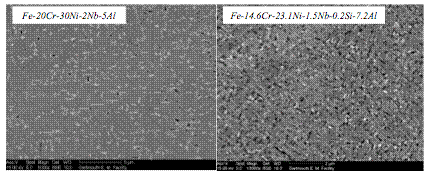57th Annual Report on Research 2012 Under Sponsorship of the ACS Petroleum Research Fund
Reports: ND1049157-ND10: Novel High-Temperature Austenitic Alloys for Energy Conversion Applications
Ian Baker, PhD, Dartmouth College
Despite advances being made in non-fossil technologies, it is understood that for the near future there will be a continued dependence on the energy created by fossil fuels. The materials needed for fossil fuel power plant applications have traditionally been those that maximize efficiency and decrease costs. More recently, there has been an added demand to limit the amount of CO2 emissions. In boiler-steam turbine power plants, increasing the temperature and pressure of the steam leads to an increase in efficiency, and thermal efficiency has the added benefit of reducing CO2 emissions. Therefore, there is a need for materials that can withstand the corrosive environment in supercritical power plants that are also capable of withstanding high-temperatures (>700 °C). The high cost of nickel-based superalloys make them less desirable for most applications and ferritic steels are generally not suitable for high temperatures.
AFAs (alumina-forming austenitic stainless steels) are a new promising class of steels that could be used. However, in order for these materials to be viable, they must have better strength and creep resistance. We saw potential in using intermetallic precipitates such as Laves phase Fe2Nb to enhance AFAs. We sought to improve their strengthening capabilities by reducing their size and increasing the volume fraction of precipitates in the matrix. Smaller precipitates would effectively pin dislocations and improve creep life. Formation of these precipitates was investigated in two AFA-based-alloys, Fe-20Cr-30Ni-2Nb-5Al and Fe-14.6Cr-23.1Ni-1.5Nb-0.2Si-7.2Al (compositions in at. % throughout). Both alloys were fully austenitic solutions supersaturated with Nb after being homogenized at 1250°C for 24 hours.
Fe-20Cr-30Ni-2Nb-5Al
Backscattered electron (BSE) images in a scanning electron microscope (SEM) and tensile test data were collected for the Fe-20Cr-30Ni-2Nb-5Al alloy before heat treatment and after 2.4, 24, and 240 h aging at 800°C (Figure 1). Transmission electron microscopy was performed to verify the presence of both C14 Fe2Nb (Figure 2) and ordered body-centered-cubic or B2 NiAl precipitates in the matrix (Figures 3). An increase in aging time from 2.4 to 24 h saw a marked increase in the volume fraction of Laves phase precipitates. The volume fraction present at 240 h, was comparable to the volume fraction present at 24 h, and the C14 Laves phase precipitates appeared to be coupled with B2 NiAl precipitates in the matrix. Increasing the aging time led to an increase in tensile strength, but a decrease in ductility (Table I). It is interesting to note that on increasing the aging time from 24 to 240 h, the strength improved from 671 to 788 MPa with little corresponding change in the ductility even though the grain boundary coverage of the precipitates increased.
Figure 1: BSE images of Fe-20Cr-30Ni-2Nb-5Al after homogenization anneal and subsequent 2.4, 24, and 240 h aging treatments at 800°C. The dark precipitates are the Fe2Nb Laves phase and the light precipitates are B2 NiAl.
The alloy was also cold-worked via cold-rolling to thickness reductions of 25%, 50% and 90%. The microstructure obtained after cold rolling was compared with that of material that had not been cold-worked prior to aging. Cold-worked samples had a defect structure present that facilitated heterogeneous nucleation of not only C14 Fe2Nb, but also B2 NiAl within the matrix. A promising combination that includes a thickness reduction of 90% and a subsequent 700°C, 240 h aging treatment exhibited the finest C14 Fe2Nb precipitates (0.17µm feret diameter) (Figure 4).
Figure 2: a) TEM bright field micrograph showing Laves phase Fe2Nb precipitate in a Fe-20Cr-30Ni-2Nb-5Al specimen; b) [001] CBED from precipitate; c) simulated [001] CBED for C14 Laves phase; d) [101] CBED from precipitate; and e) simulated [101] CBED for C14 Laves phase.
Figure 3: a) TEM bright field micrograph showing B2 NiAl precipitate in Fe-20Cr-30Ni-2Nb-5Al specimen; b) [001] CBED from precipitate; and c) simulated [001] CBED.
Table I: Tensile Properties of Fe-20Cr-30Ni-2Nb-5Al.
800 °C Aging (h) | YS (MPa) | UTS (MPa) | % elongation |
0 | 197 | 264 | 42 |
2.4 | 317 | 489 | 36 |
24 | 433 | 671 | 19 |
240 | 409 | 788 | 19 |
Figure 4: SEM BSE micrographs from Fe-20Cr-30Ni-2Nb-5Al specimens aged: a) 2.4 h at 800°C; b) 90% cold roll, 2.4 h at 800°C; c) 90% cold roll, 24 h at 700°C; d) 24 h at 800°C; e) 90% cold roll, 24 h at 800°C; and f) 90% cold roll, 240 h at 700°C. Images b, c, e and f all show smaller, higher-volume fraction second-phase precipitates compared with the non-cold-rolled specimens in a and d.
Fe-14.6Cr-23.1Ni-1.5Nb-0.2Si-7.2Al
This alloy was investigated in order to utilize the silicon, which is known to refine and stabilize the size of Fe2Nb Laves phase precipitates. The alloy had precipitates (darker phase) rich in nickel and aluminum precipitating earlier in the aging process (Figure 5). Compared to the previous alloy, this material showed higher yield strength after 2.4 h and 24h anneals, but a lower yield strength after a 240 h anneal, and decreased ductility at all aging times (Table II).
Figure 5: BSE micrographs from Fe-20Cr-30Ni-2Nb-5Al and Fe-14.6Cr-23.1Ni-1.5Nb-0.2Si-7.2Al specimens aged at 800°C for 24 h.
Table II: Tensile Properties of Fe-14.6Cr-23.1Ni-1.5Nb-.2Si-7.2Al
800 °C Aging (h) | YS(MPa) | UTS (MPa) | % elongation |
0 | 184 | 350 | 38 |
2.4 | 513 | 797 | 14 |
24 | 489 | 817 | 14 |
240 | 341 | 550 | 9 |
Support from the ACS Petroleum Research Fund enabled the author to pursue a novel area of research. The results obtained from this study were promising and a more in-depth analysis of these systems is currently underway. This work was the focus of a Master's thesis (Garrett Rayner), gave undergraduates (Alex Hanson and Curtis Lim) experience with material's research, and provided a topic of study for a current Ph.D. student (Geneva Trotter).















